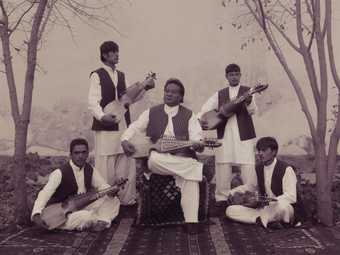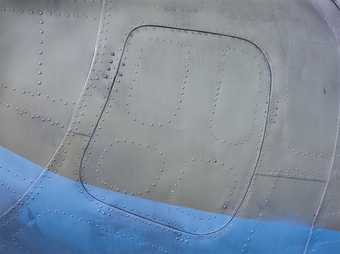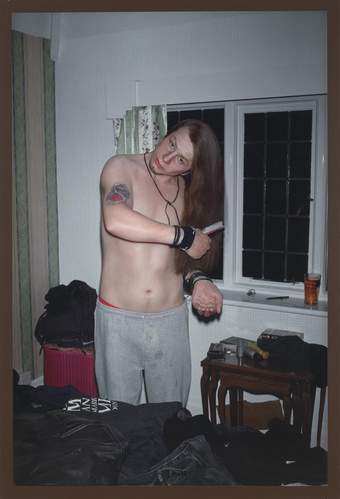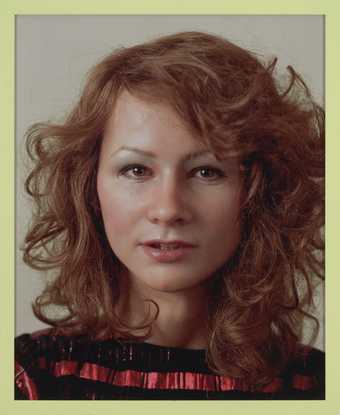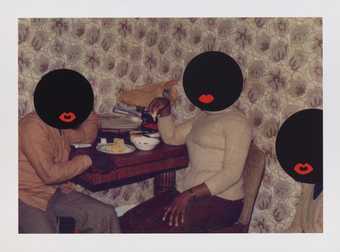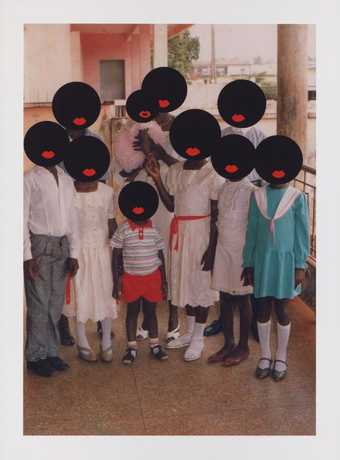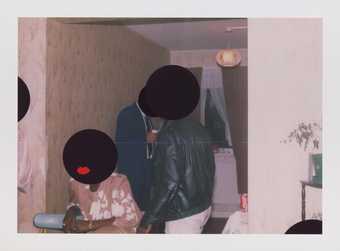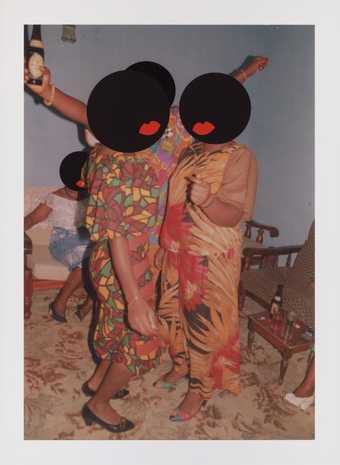
Not on display
- Artist
- Larry Achiampong born 1984
- Medium
- Photograph, digital c-print on paper
- Dimensions
- Image: 588 × 405 mm
frame: 685 × 516 × 45 mm - Collection
- Tate
- Acquisition
- Purchased with funds provided by the 2020 Frieze Tate Fund supported by Endeavor to benefit the Tate collection 2021
- Reference
- P82633
Summary
This is one of a group of photographs in Tate’s collection by Larry Achiampong (see Tate P15463, P82629–P82634). Spanning a number of years, they form part of an ambitious and ongoing photographic project that seeks to examine how homogenising racist stereotypes obfuscate and dehumanise the identities of Black people. The digitally manipulated photographs are derived from family photograph albums, showing individuals and family groups. In each case, the heads of the figures have been replaced with identical black circles bearing no features other than a pair of bright red lips. The original source photographs were all drawn from Achiampong’s own family archive, passed to him by his mother. In fact, most were taken by his mother and he considers her as an integral part of a collaborative conversation. Achiampong began working through these family archives in 2013 and has gradually been selecting images that speak to him from across family members, time and place. Some, like Integer #3, Glyth Series 1 #3, Glyth Series 2 #2 and Glyth Series 2 #3, are formally posed, the protagonists in smart dress; one can imagine that their eyes, though obscured, would be looking at the camera. In contrast, the scenes in Cipher #1, Decimal #3 and Speckle #1 capture the immediacy and informality of everyday life. Each title – ‘Cipher’, ‘Glyth’, ‘Integer’ and ‘Speckle’ – refers in an abstract way to the shape of the black dots that replace each of the faces.
In obscuring the faces of every Black figure in the photographs, Achiampong seeks to replicate the hurt that homogenising racist stereotypes creates in effectively reducing all of these figures to a generic ‘black’, with their individual identities erased – a homogeneity that the rest of the image in each case refutes through the subjects’ personal choice of clothes, actions and surroundings. Achiampong has described coming up with the motif of the black head with red lips: ‘I was interested in depicting the experience of being categorised and treated like an alien based on the colour of my skin and my origins. I instinctively used Photoshop to create this very simple avatar and when I would present my work to young people they’d refer to it as “cloudface”.’ (Interview with OkayAfrica, 9 October 2013, https://www.okayafrica.com/larry-achiampong-cloudface-blackface-tate-modern/, accessed 15 October 2020.) In 2013 Achiampong created a performance at Tate Modern entitled Cloud, for which performers moved through the museum collection displays wearing a black sphere on their head emblazoned with the same distinct red lips seen in the artist’s photographs.
The intimacy of the family portraits used by Achiampong, themselves an index of Black survival in a hostile 1980s Britain, is interrupted by the derogatory iconography of Blackness associated with blackface performance, ‘golliwog’ dolls and the pickaninny caricature. But it is also this interruption that serves to remind the viewer of the history of the British Empire, colonialism and its more domestic forms of racism. In Achiampong’s words, ‘just because Golliwogs and Blackface are not paraded in the way they were in the past, it doesn’t mean the world has thrown that type of mentality to the dust. I think in the UK we are quite guilty of sweeping moments like these under the carpet in the hope that no one will unearth them.’ (Interview with OkayAfrica, 9 October 2013, https://www.okayafrica.com/larry-achiampong-cloudface-blackface-tate-modern/, accessed 15 October 2020.)
This comment illustrates how the artist’s aesthetic is distilled from a variety of childhood experiences centring around his direct familiarity with racism as a young child growing up in East London in the 1980s and 1990s. The black circles overset with red lips are an unsettling allusion to the ‘golliwog’, the character represented on Robertson’s marmalade jars, that Achiampong would see as a child during breakfast and other family meals. The ‘golliwog’ character was only removed from Robertson’s marmalade jars in 2001.
Further reading
‘Blackface At The Tate: Artist Larry Achiampong On Britain’s “Others”’, OkayAfrica, 9 October 2013, https://www.okayafrica.com/larry-achiampong-cloudface-blackface-tate-modern/, accessed 15 October 2020.
Celeste-Marie Bernier (ed.), Stick to the Skin: African American and Black British Art, 1965–2015, Oakland, California 2018.
Nathan Ladd
October 2020
Does this text contain inaccurate information or language that you feel we should improve or change? We would like to hear from you.
You might like
-
Larry Achiampong Glyth Series 1 #3
2013 -
Simon Norfolk A view of Kabul city centre from Bala Burj.
2011 -
Simon Norfolk Kandahar Air Field.
2011 -
Simon Norfolk Watchtowers on the perimeter of Camp Bastion.
2011 -
Gillian Wearing CBE Self Portrait as My Brother Richard Wearing
2003 -
Gillian Wearing CBE Self Portrait as My Sister Jane Wearing
2003 -
Larry Achiampong Cipher #1
2015 -
Larry Achiampong Integer #3
2015 -
Larry Achiampong Decimal #3
2017 -
Larry Achiampong Glyth Series 2 #2
2018 -
Larry Achiampong Speckle #1
2020




